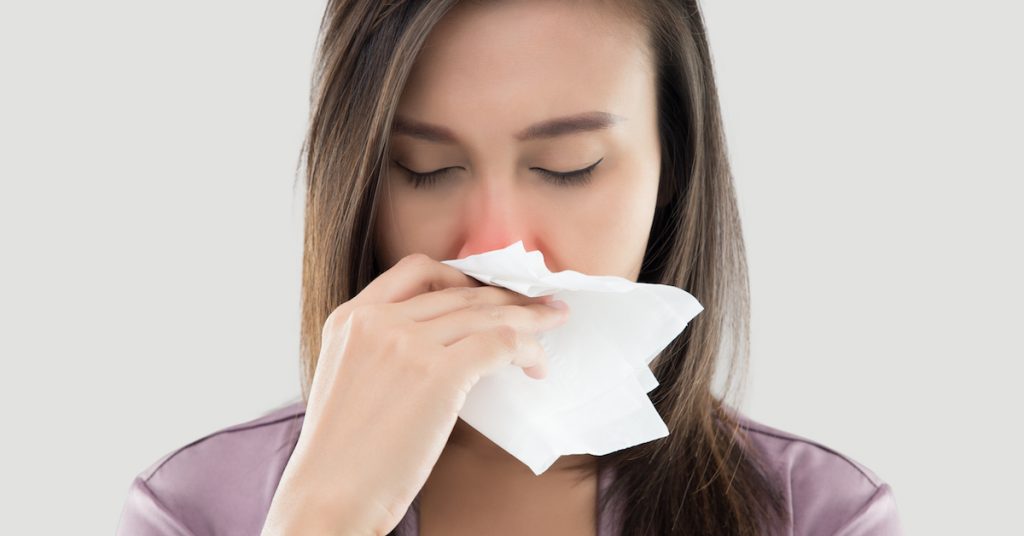
Every day, glands in your nose and throat produce an average of one to two quarts of mucus. Although it may not be a pleasant topic to talk about, mucus is essential for keeping the nasal membranes clean and moist, humidifying the air that you breathe, clearing the nasal passages of foreign particles, and fighting infection. In most cases, you swallow the mucus unconsciously. If the mucus becomes excessively thick or if it cannot drain properly, the sensation of it dripping from the back of the nose or accumulating in the throat is called post-nasal drip. Constant post-nasal drip can indicate anything from allergies to a sinus blockage.
What Causes Post-Nasal Drip?
To help you figure out how to stop it, FastMed wants you to understand what causes post-nasal drip.
Thin Secretions
Allergies can cause you to produce large amounts of thin, watery mucus resulting in constant post-nasal drip. Environmental factors, such as cold temperatures or bright lights, can trigger the body to produce excess mucus. You may also notice an increase in mucus secretions after eating spicy foods, when pregnant or undergoing hormonal changes, or when taking certain medications, such as oral contraceptives and blood pressure medications.
Thick Secretions
During the winter, when humidity levels are low and the heat sources that we use in our homes and offices draw additional moisture out of the air, nasal secretions can become thicker. As a result, they can accumulate more in the sinuses and throat leading to sinus congestion and post-nasal drip. Certain food allergies, such as allergies to dairy products, can also trigger the production of thick mucus. Exposure to environmental irritants, such as cigarette smoke and automobile fumes, can irritate and damage the delicate mucous membranes. As a result, nasal secretions decrease and become thicker than normal making it harder for the secretions to drain and causing the sensation of excess mucus.
Miscellaneous Causes of Post-Nasal Drip
- A deviated septum, abnormal growths, or other structural abnormalities of the nose and sinuses can alter the way air flows through the nasal passages, leading to an increase or decrease of nasal secretions.
- It is normal for the mucous membranes to shrink and become drier with age. This causes nasal secretions to become thicker, which can be perceived as post-nasal drip.
- Problems involving the nerves or muscles used for swallowing or abnormal growths in the food passages can allow food and fluids to back up into the larynx, trachea, and bronchi, resulting in symptoms similar to post-nasal drip, such as hoarseness and frequent throat clearing.
Signs That You May Need Post-Nasal Drip Treatment
Bacteria thrive in a warm, moist environment. This means that excessive mucus or thick mucus that does not drain properly creates the perfect environment for a sinus infection. Thick mucus that is yellow or green is a common sign that a bacterial infection may be developing.
In young children, thick secretions that only come from one side of the nose may be an indication that a foreign body, such as a toy or a bean, may be lodged in the nose. As long as the child is still able to breathe and is not in distress, it is best to have a medical professional remove the object. Attempting to extract the object yourself may simply move it further into the nasal passage or cause other damage.
What Is the Best Post-Nasal Drip Treatment?
Choosing the correct post-nasal drip remedy depends on the cause of the symptoms.
- For bacterial infections, the post-nasal drip remedy is typically a course of antibiotics.
- Post-nasal drip caused by allergies can be managed by avoiding the allergen and using over-the-counter medications, including antihistamines, decongestants, and nasal sprays. It is important to note that certain antihistamines, decongestants, and sprays may exacerbate make post-nasal drip symptoms worse and may not be appropriate for individuals with certain health conditions, so you should consult a doctor before taking any of these medications.
- Increasing fluid intake and mucus-thinning medications, such as guaifenesin, may help alleviate congestion by thinning out the secretions so that they can drain.
- If you are looking for a natural post-nasal drip remedy, you can try nasal irrigation using a nasal rinse aid like a netti pot or nozzle and a mixture of warm water, baking soda, and salt.
- Surgery may be required if your symptoms are caused by a septal defect, polyps, or another physical blockage.
Post-Nasal Drip Treatment at FastMed Urgent Care Clinics
FastMed can diagnose the source of your sinus issues and help you figure out how to stop nasal drip symptoms. We have convenient clinics located throughout Texas, Arizona, and North Carolina that are open seven days a week to serve you.
About FastMed
FastMed is a leading provider of high-quality, convenient, affordable, and compassionate healthcare in 34 counties across North Carolina. FastMed serves both urban and rural communities across the state with a wide range of care options, including preventive, telemedicine, occupational health, and primary and urgent care. FastMed is one of the few urgent care providers in the nation that has earned The Joint Commission’s coveted Gold Seal of Approval® for quality, safety, and infection control in ambulatory healthcare. For more information, visit www.fastmed.com.